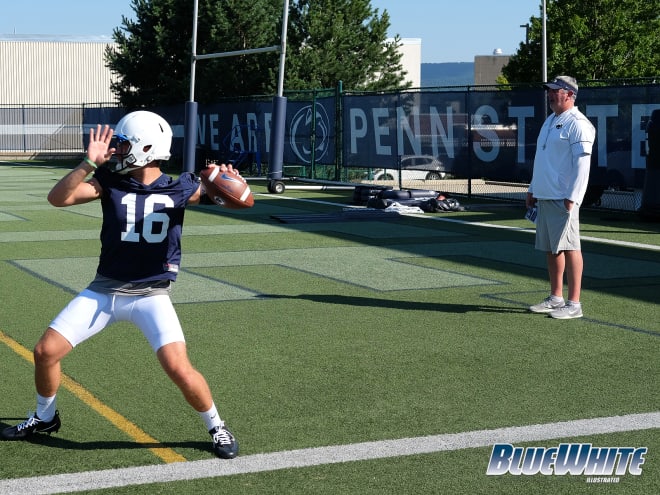Column: Point, Moorhead
One minute, 51 seconds into a running soliloquy, Joe Moorhead was ready to answer the question.
Meeting with the press Saturday afternoon as part of the program’s annual preseason media day, Penn State’s second-year offensive coordinator had something on his mind. So when sensing an opening, processing a question regarding quarterback Trace McSorley’s next evolutionary step, Moorhead walked right into it.
“His next step?” Moorhead asked, wheels turning. “Well, I think that brings up an interesting topic.”
The author of a remarkable turnaround in offensive performance for the Nittany Lions during the 2016 season, helping lift Penn State from the dregs of a ghastly 23.2 points per game average to a mark of 37.6, Moorhead started in on what he described as a “prevailing” thought process.
Namely - that McSorley had made a habit of dropping back to pass, picking the deepest receiver, flinging the football with all his might, then crossing fingers to hope his receiver would make the play - was a farce.
“Frankly, this is a gross mischaracterization, number one, of the application of our offense and [number two] the role of the quarterback,” said Moorhead. “That's, in a lot of ways, ridiculous at best and, quite frankly, asinine at worst.”
Moorhead was just getting started.
Rolling through all of the ways Penn State’s offense proved itself to be a well-designed, well-executed system during the course of the year, Moorhead wanted to upend something that he’d likely seen and heard enough of during the offseason.
And to a certain extent, I’d already become intimately familiar with the lesson he sought to teach.

Meeting with Moorhead in his office at the Lasch Building in June for our yearly sit-down interview, a certain line of questioning prompted a similar response early in our lively, fun back-and-forth.
Having already explained his primary priorities for the offense - focusing on points per game, explosive plays and turnover margin - Moorhead explained the strong link between the three statistical categories and Penn State’s success in the wins and loss column historically. He said there was “absolutely” still room for the offense to grow in its second year, a likely product of due diligence through the offseason, tweaking the successes and eliminating the failures of the system specific to the Nittany Lions’ personnel.
“The old adage, ‘When the defense thinks they have the answer, we want to change the question. If it's a virus and they have the vaccination, we want the strain to mutate a little bit,’” Moorhead explained. “So we're not changing anything wholesale, but there are going to be always little variations and things that we research within our own scheme that we can find a way to do a little bit better.”
To my ear, the response sounded like a reasonable prompt toward asking the question many people, admittedly including myself, had wondered through the course of Penn State’s run to the Rose Bowl:
“How much control over the explosive play aspect of the offense do you have? To the outside perspective [ed. note: cop-out] a lot of explosive play success that you had appeared to be on broken plays built on Trace's ability to extend plays. They didn't necessarily seem straightforward,” I asked.
Like a fox toying with its prey, Moorhead pounced.
“I would say it's the exact opposite of that. While there were some plays during the course of the season that the outcome of them was based on our players making a play, I would argue that if you go through game-by-game, that a majority of our explosive plays and touchdowns were created and executed within the framework of the offense,” said Moorhead. “Finding a one-on-one matchup, I mean, there's something to that.
“And the notion that we're just closing our eyes and throwing the ball up and asking our kids to make a play, to me I think is farcical in a lot of ways. You go back and really look at it, a lot of our things are finding a way to create the one-on-one matchup. If you would go through it with a fine-tooth comb, some of those plays stick out because they're highlight reel plays, but the majority of the things that we did to create explosive plays and touchdowns were I think well game-planned, well-called, and incredibly well-executed plays by our kids.”
Point, Moorhead.
Continuing, McSorley’s nation-leading 16.13 yards per completion seemed the next logical place to go.
Declining to say the statistic was something he’d ever defined as a goal, Moorhead explained how its outcome was something that happens organically within the framework of the offense.
“We look to run the ball successfully and when we weren't able to do that, people have to take it away by either pressure or secondary support, and when you do that it creates one-on-one matchups on the perimeter,” said Moorhead. “So this isn't something where, from an offensive system standpoint, that we just decided to take deep shots down the field. You go back and look at the Fordham numbers, to a certain extent UConn and probably a little more Akron, this has been a system that in a pass game is based on West Coast principles and the ability to throw the ball down the field, coupled with an RPO-based spread run system. That's why I think you see the results you do.
“It's kind of a hybrid spread that allows us to push the ball down the field in the pass game but still experience the benefits of a spread run game, if that makes sense.”
To those not yet privy to Nate Bauer’s official "Decoding the phrases of Penn State’s coaching staff" dictionary, the oft-used “if that makes sense” is short for, “do you need me to draw a diagram?”
Looking back at the numbers, the statistical category’s history proved Moorhead’s words true. Kevin Anderson’s 13.9 yards per completion was good for 14th nationally at Fordham in 2015. The year Prior, senior Michael Nebrich held No. 18 in the category at 13.33 ypc.
Another point awarded to Moorhead.
Still, having generated the perception of a feast-or-famine, big play offense in 2016, would a shift toward a higher number of ball-control plays be preferable?
Tossing up one final lob, this interviewer was about to suffer an overhead slam.
“If they happen within the framework of the offense,” said Moorhead. “Not to get incredibly technical, but when we call a pass play, generally speaking there were plenty of medium to non-explosive pass completions in the system, but I think that what ends up happening is, they get overshadowed by the ones that are going 50 and 60 yards down the field.
“So to say we're pressing to get more 10-yard completions and less 60-yard completions, I don't think we're aiming to do that, but ultimately it's about scoring points, creating explosive plays, eliminating turnovers and however you have to go about that, if it's a series of 10-yard completions, fantastic. If it's one 60-yard pass down the field, then that will work too. Whatever it takes.”
Game, set, match. Moorhead.
Though Saturday’s questioner likely hadn’t provided fodder for the same explanation, Moorhead offered a similar one anyway.
“You hear people say, “Well, are you guys going to be able to consistently live on the 50-50 ball down the field?” That's not what we do,” said Moorhead. “Our offense is designed to stretch defenses horizontally and vertically and create mismatches by a number of personnel. So the things that we did throwing the ball down the field, they didn't happen by chance, they happened by choice.”
On a crusade to rectify misconceptions of an offense aiming to make even bigger strides in the season ahead, Moorhead provided another free education.
